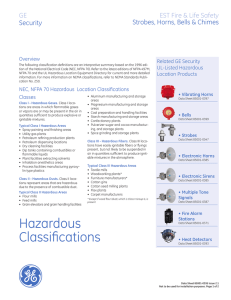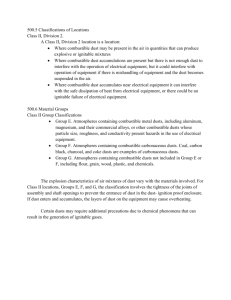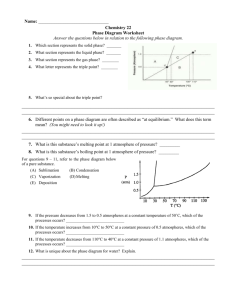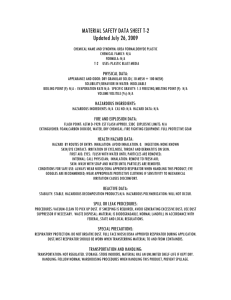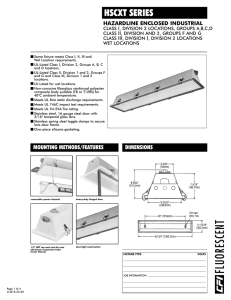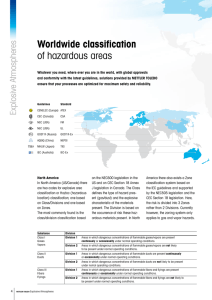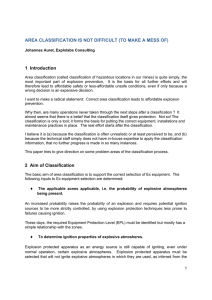NEC, IP and NEMA/IEC Ratings
advertisement
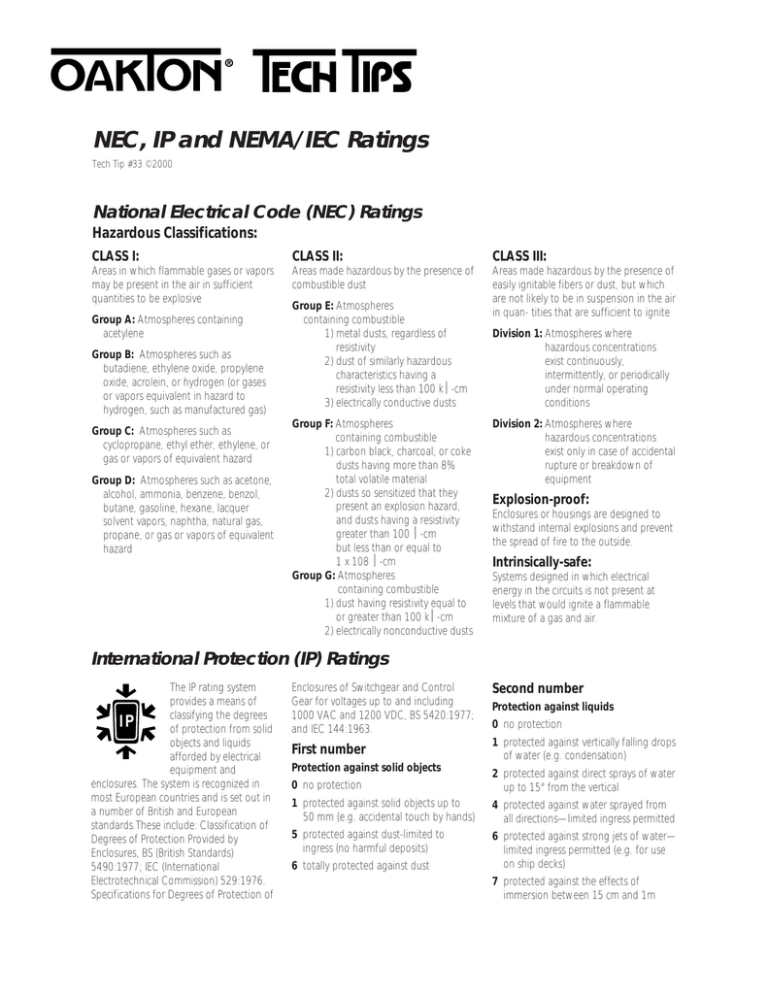
NEC, IP and NEMA/IEC Ratings Tech Tip #33 ©2000 National Electrical Code (NEC) Ratings Hazardous Classifications: CLASS I: CLASS II: CLASS III: Areas in which flammable gases or vapors may be present in the air in sufficient quantities to be explosive Areas made hazardous by the presence of combustible dust Areas made hazardous by the presence of easily ignitable fibers or dust, but which are not likely to be in suspension in the air in quan- tities that are sufficient to ignite Group A: Atmospheres containing acetylene Group B: Atmospheres such as butadiene, ethylene oxide, propylene oxide, acrolein, or hydrogen (or gases or vapors equivalent in hazard to hydrogen, such as manufactured gas) Group C: Atmospheres such as cyclopropane, ethyl ether, ethylene, or gas or vapors of equivalent hazard Group D: Atmospheres such as acetone, alcohol, ammonia, benzene, benzol, butane, gasoline, hexane, lacquer solvent vapors, naphtha, natural gas, propane, or gas or vapors of equivalent hazard Group E: Atmospheres containing combustible 1) metal dusts, regardless of resistivity 2) dust of similarly hazardous characteristics having a resistivity less than 100 kΩ-cm 3) electrically conductive dusts Group F: Atmospheres containing combustible 1) carbon black, charcoal, or coke dusts having more than 8% total volatile material 2) dusts so sensitized that they present an explosion hazard, and dusts having a resistivity greater than 100 Ω-cm but less than or equal to 1 x 108 Ω-cm Group G: Atmospheres containing combustible 1) dust having resistivity equal to or greater than 100 kΩ-cm 2) electrically nonconductive dusts Division 1: Atmospheres where hazardous concentrations exist continuously, intermittently, or periodically under normal operating conditions Division 2: Atmospheres where hazardous concentrations exist only in case of accidental rupture or breakdown of equipment Explosion-proof: Enclosures or housings are designed to withstand internal explosions and prevent the spread of fire to the outside. Intrinsically-safe: Systems designed in which electrical energy in the circuits is not present at levels that would ignite a flammable mixture of a gas and air. International Protection (IP) Ratings The IP rating system provides a means of classifying the degrees IP of protection from solid objects and liquids afforded by electrical equipment and enclosures. The system is recognized in most European countries and is set out in a number of British and European standards.These include: Classification of Degrees of Protection Provided by Enclosures, BS (British Standards) 5490:1977; IEC (International Electrotechnical Commission) 529:1976. Specifications for Degrees of Protection of Enclosures of Switchgear and Control Gear for voltages up to and including 1000 VAC and 1200 VDC, BS 5420:1977; and IEC 144:1963. First number Protection against solid objects Second number Protection against liquids 0 no protection 1 protected against vertically falling drops of water (e.g. condensation) 0 no protection 2 protected against direct sprays of water up to 15° from the vertical 1 protected against solid objects up to 50 mm (e.g. accidental touch by hands) 4 protected against water sprayed from all directions—limited ingress permitted 5 protected against dust-limited to ingress (no harmful deposits) 6 protected against strong jets of water— limited ingress permitted (e.g. for use on ship decks) 6 totally protected against dust 7 protected against the effects of immersion between 15 cm and 1m Tech Tip #33 page 2 NEMA/IEC Enclosure Ratings NEMA enclosure type no. 1 2 3 and 3S 3R 4 and 4X 5 6 and 6P 7 8 9 10 11 12 and 12K 13 NEMA definition General-purpose. Protects against dust, light, and indirect splashing but is not dust-tight; primarily prevents contact with live parts; used indoors and under normal atmospheric conditions. Drip-tight. Similar to Type 1 but with addition of drip shields; used where condensation may be severe (as in cooling rooms and laundries). (as in cooling rooms and laundries). Weather-resistant. Protects against weather hazards such as rain and sleet; used outdoors on ship docks, in construction work, and in tunnels and subways Intended for outdoor use. Provides a degree of protection against falling rain and ice formation. Meets rod entry, rain, external icing, and rust-resistance design tests. Watertight (weatherproof). Must exclude at least 65 GPM of water from 1-in. nozzle delivered from a distance not less than 10 ft for 5 min. Used outdoors on ship docks, in dairies, and in breweries. Dust-tight. Provided with gaskets or equivalent to exclude dust; used in steel mills and cement plants. Submersible. Design depends on specified conditions of pressure and time; submersible in water; used in quarries, mines, and manholes. Hazardous. For indoor use in Class I, Groups A, B, C, and D environments as defined in the NEC. Hazardous. For indoor and outdoor use in locations classified as Class I, Groups A, B, C, and D as defined in the NEC. Hazardous. For indoor and outdoor use in locations classified as Class II, Groups E, F, or G as defined in the NEC. MSHA. Meets the requirements of the Mine Safety and Health Administration, 30 CFR Part 18 (1978). General-purpose. Protects against the corrosive effects of liquids and gases. Meets drip and corrosion-resistance tests. General-purpose. Intended for indoor use, provides some protection against dust, falling dirt, and dripping noncorrosive liquids. Meets drip, dust, and rust resistance tests. General-purpose. Primarily used to provide protection against dust, spraying of water, oil, and noncorrosive coolants. Meets oil exclusion and rust resistance design tests. OAKTON Instruments OAKTON Reg. TM #1,692,543 IEC enclosure class IP10 IP11 IP54 . IP14 IP56 IP52 IP67 — — — — — IP52 IP54
